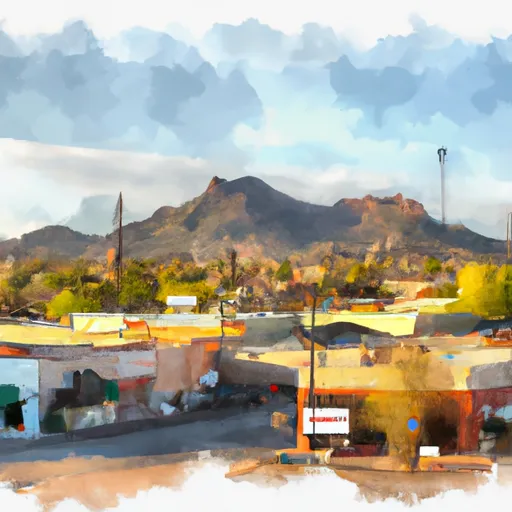-
 Snoflo Premium
Snoflo Premium
Get unlimited access to all our content
With no Ad interruptions! - Start Your Free Trial Login with existing account
Portal
Eden Index
Climate
8.8
•
Recreation
7.3
•
Community
•
Safeguard
6.1/10

Portal, Arizona is a small unincorporated community located in Cochise County. Situated at an elevation of approximately 4,600 feet, it enjoys a unique semi-arid climate characterized by mild winters and cool summers. The area experiences around 20 inches of precipitation annually, with most of it occurring during the summer monsoon season. This contributes to the rich hydrology constituents in the region, as Portal is nestled in the heart of the Chiricahua Mountains. The area is known for its diverse and abundant wildlife, including various bird species and reptiles.
Portal offers excellent outdoor recreation opportunities for nature enthusiasts. The Chiricahua Mountains afford opportunities for hiking, camping, and wildlife viewing. The renowned Chiricahua National Monument, just a short drive away, features stunning rock formations and trails that showcase the area's natural beauty. Additionally, the nearby Cave Creek Canyon is a popular spot for birdwatching, with over 200 species recorded. Visitors can also explore the Coronado National Forest, which surrounds the area, and offers opportunities for fishing, horseback riding, and scenic drives. With its pleasant climate, diverse hydrology, and abundant outdoor activities, Portal is a hidden gem for nature lovers seeking an adventurous and scenic escape. (169 words)
What is the Eden Index?
The Snoflo Eden Index serves as a comprehensive rating system for regions, evaluating their desirability through a holistic assessment of climate health, outdoor recreation opportunities, and natural disaster risk, acknowledging the profound impact of these factors on livability and well-being.
Climate Health Indicator (CHI): 8.8
Portal receives approximately
316mm of rain per year,
with humidity levels near 46%
and air temperatures averaging around
17°C.
Portal has a plant hardyness factor of
8, meaning
plants and agriculture in this region tend to thrive here all year round.
By considering the ideal temperature range, reliable water supplies, clean air, and stable seasonal rain or snowpacks, the Climate Health Indicator (CHI) underscores the significance of a healthy climate as the foundation for quality living.
A healthy climate is paramount for ensuring a high quality of life and livability in a region, fostering both physical well-being and environmental harmony. This can be characterized by ideal temperatures, reliable access to water supplies, clean air, and consistent seasonal rain or snowpacks.
Weather Forecast
Streamflow Conditions
Upper Gila
Area Rivers
Upper Gila
Snowpack Depths
Upper Gila
Reservoir Storage Capacity
Upper Gila
Groundwater Levels
Recreational Opportunity Index (ROI): 7.3
The Recreational Opportunity Index (ROI) recognizes the value of outdoor recreational options, such as parks, hiking trails, camping sites, and fishing spots, while acknowledging that climate plays a pivotal role in ensuring the comfort and consistency of these experiences.
Access to outdoor recreational opportunities, encompassing activities such as parks, hiking, camping, and fishing, is crucial for overall well-being, and the climate plays a pivotal role in enabling and enhancing these experiences, ensuring that individuals can engage in nature-based activities comfortably and consistently.
Camping Areas
| Campground | Campsites | Reservations | Toilets | Showers | Elevation |
|---|---|---|---|---|---|
| Pinery Canyon | 4 | 7,025 ft | |||
| Rucker Forest Camp | 14 | 6,195 ft | |||
| West Turkey Creek | 7 | 5,911 ft | |||
| Idlewilde | 9 | 4,979 ft | |||
| Herb Martyr | 7 | 5,801 ft | |||
| Cypress Park | 7 | 6,040 ft | |||
| Bathtub | 11 | 6,090 ft | |||
| Rustler Park | 25 | 8,446 ft | |||
| John Hands | 5 | 5,604 ft | |||
| Rucker Lake | 8 | 6,128 ft |
Nearby Ski Areas
Catastrophe Safeguard Index (CSI):
The Catastrophe Safeguard Index (CSI) recognizes that natural disaster risk, encompassing floods, fires, hurricanes, and tornadoes, can drastically affect safety and the overall appeal of an area.
The level of natural disaster risk in a region significantly affects safety and the overall livability, with climate change amplifying these risks by potentially increasing the frequency and intensity of events like floods, fires, hurricanes, and tornadoes, thereby posing substantial challenges to community resilience and well-being.
Community Resilience Indicator (CRI):
The Community Resilience Indicator (CRI) recognizes that education, healthcare, and socioeconomics are crucial to the well-being of a region. The CRI acknowledges the profound impact of these elements on residents' overall quality of life. By evaluating educational resources, healthcare accessibility, and economic inclusivity, the index captures the essential aspects that contribute to a thriving community, fostering resident satisfaction, equity, and social cohesion.

